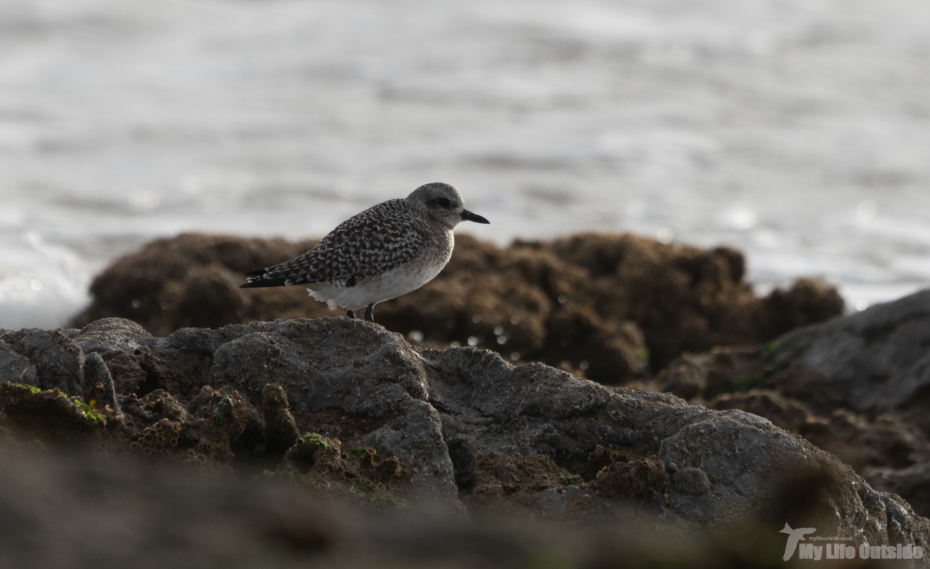Lackey Moth caterpillars (Malacosoma neustria) were present in great numbers along the Pembrokeshire coast both north and south of St Davids last weekend. This species belongs to a family of tent caterpillars, so called because of the distinctive silk ‘tents’ that the newly emerged caterpillars build. These tents are positioned to intercept the early morning sun so that the caterpillars contained within can elevate their body temperature as quickly as possible during early spring. The tents are constructed from distinct layers of silk separated by air gaps to form separate compartments, the temperatures of which can vary widely. By moving between these compartments the caterpillars can regulate their body temperatures as necessary throughout the day. The sections of the coast path that we walked were lined with huge quantities of these tents, many of them still containing masses of newly emerged caterpillars.
As Lackey Moth caterpillars develop they go through several growth stages, shedding their exoskeleton during each transformation. Their initial form is shown in the photo above, while their final and more colourful form is shown in the photo at the top of this post. Many of the exoskeletons were still hanging around the tents as shown in the left of the photo below.
As you can probably imagine, this quantity of caterpillars in one place can have a massive impact on the surrounding vegetation. New tent locations were easy to spot as typically the surrounding bushes had been stripped completely bare of all their leaves. This probably explains why we saw several of the caterpillars travelling across the path at various points, no doubt in search of fresh food sources. The photos below show the results of their huge appetite.
I have never seen these caterpillars or their tents before so I’m not sure if we were particularly lucky this time around or if they have had a bumper year. Wikipedia mentions that these species often exhibit a boom or bust breeding mentality so it is quite likely that this year has seen a population explosion. I’d be interested to hear from anyone else who has seen these creatures on their travels.








8 Comments
TexWisGirl · June 1, 2011 at 10:59 pm
oh my word!!! that's a tent city! 🙂
i can't imagine all of those caterpillars munching away! their little 'nose-like' face is fascinating though!
Caroline Gill · June 1, 2011 at 11:16 pm
I've got a bit more to say on this (and a link to find and add), but it's 23.14 – so for now just to let you know that I saw a similar bush from the car as we drove over the Beacons yesterday. Can't be sure it was exactly the same species as we were cutting it fine for a festival event and didn't stop … but it was certainly a caterpillar tent of the kind you show and describe.
holdingmoments · June 2, 2011 at 5:35 am
Fascinating Adam.
I've never seen these before, but something very similar here, called a Bird Cherry Ermine Moth. I've done a couple of posts in the past about them; they do a very similar thing. Cover a tree or shrub in silk, and defoliate the plant.
Nature never ceases to amaze me.
Caroline Gill · June 2, 2011 at 10:51 am
The links to my two previous posts of the 'tent' caterpillar phenomenon (about which I know very little – but enjoy observing) are here (Scotland) and here (Spurn Head). With reference to holdingmoments' message above, you will notice that the Bird Cherry Ermine features in the comments under my Scottish post.
Adam Tilt · June 2, 2011 at 12:39 pm
Thanks for the information and links Caroline. It's very interesting to hear that there are similar species in the Beacons so I may venture up that way to see if I can find any. Reading up on the Bird Cherry Ermines it's impressive how plant specific some of these species can be.
Thanks Keith. Caroline has also mentioned the Bird Cherry Ermine moth, another species I have not heard of before. I'll go and check out the posts concerning them on your blog as well.
Certainly was texwsgirl. I think these caterpillars have the best 'faces' of any that I have seen thus far.
Hilke Breder · June 2, 2011 at 10:16 pm
Fascinating post, Adam
Barry Stewart · June 17, 2011 at 4:28 pm
Hi Adam, some of your photos are actually of Ermine moths of the genus Yponomeuta, as well as Lackeys. There are several species so identification is not always straight forward, but Lackeys never cover bushes with webs in the same way that Ermines can. Nice shots 🙂
Unknown · July 3, 2016 at 12:18 pm
nice shairng